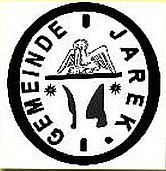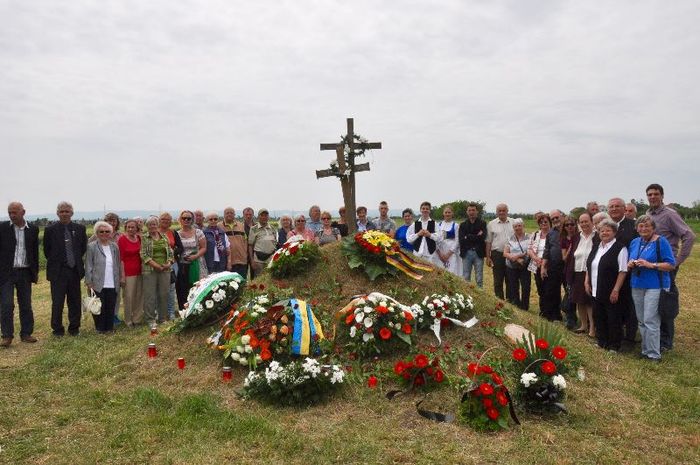Our Jarek Trip in May 2015
It was a diverse group of Jarekers and their descendants consisting of 30 persons of all age groups, as well as several other Danube Swabians, who had joined our group, when we met in the airport of Stuttgart at the counter of “Air Serbia” on May 14th. After our arrival in Belgrade we rode in a bus through the villages of Srem to Novi Sad, where we took rooms at the Hotel Centar directly across form the theater. In the afternoon, we took a sightseeing walk through the city and saw the beautiful art-nouveau houses in the pedestrian zone, the Catholic Church, the town hall and the Episcopal palace. We ate supper in the oldest restaurant of Novi Sad: “Zu den drei Linden.”
The bus took us to Katsch on Friday, May 15th. Two Katsch Serbians awaited us there, who led us to the memorabilia of our Katsch Danube-Swabian neighbors, the baptismal font and the bell of the former Lutheran church as well as to the memorial plaque for the church. Finally we drove to the small memorial at the former German cemetery, at which the HOG Katsch had set the surviving gravestones upright. What a difference to Jarek! Here in Katsch, the surviving memorabilia of the Germans lovingly preserved at central places and in Jarek the utter destruction of all things, which were reminders of our church and our dead.
The Orthodox monastery Kovil and the fortress Peterwardein were the next sightseeing places.
On Saturday, May 16th, the longed-for day of our visit in Jarek finally arrived. Expectantly we drove into the village up to the Town Hall, where we were already awaited. Our plaque still hangs intact in the hallway of the Town Hall, framed with colorful children’s drawings from the kindergarten and the elementary school.

As we entered the large room, the first great surprise came: all of the walls were covered with framed photographs of the old Jarek. Besides, large watercolors of today’s Jarek were lying on the table, which could be purchased. We were offered drinks and we could leisurely look at the many pictures. The next great surprise was the house of culture, the former “Large Tavern.” There we were provided with drinks by the youth dance group of the cultural society, and we felt as though transported into olden times. Everything looked still as it did previously. For the older ones, memories awakened of how they, as children, had looked through the windows or had visted the Mosi (Movie Theater). All of them were then still too young for dancing. After the short visit in the Orthodox Church behind the tavern, the bus took us to the makeshift memorial cross, where the commemoration was to take place. (See the report by Stefan Barth and Michael Rettinger)

The large hall in the “large tavern,” where weddings, dances, theatrical performances and movie showings took place.
Following the ceremony, we drove to the Restaurant Troglav in the Kreuzgasse for lunch.
The food was, as always, good and plentiful. After that we had the opportunity to walk through the village, in order to see what had changed since our last visit in 2010. There was many a change: several houses had been beautifully renovated, others had been torn down, and new ones had been built in their place. There were several cafés in the Hauptgasse and also another large restaurant in the lower Kreuzgasse. Some of our group were asked into their former houses, others even into strange houses. The people, whom we met, were friendly, approachable, and willing to talk to us. The time till our departure passed by very quickly and was too short, to see everything. That is enough of a reason to visit again.
We spent the evening at the Winery Vindulo outside of Temerin. There we sampled prizewinning Batschka wines and afterward we were served a genuine Danube-Swabian meal with “Hinglsupp, Paprikasch and Moagstrudl” (“chicken soup, Paprikasch and poppy seed strudel.”) We drove back to our hotel with a full stomach and very satisfied with the day.
Sunday, May 17th, was at our free disposal. Several of our group drove to other villages at their own program. Our bus took us to Temerin to an old Hungarian Batschka house with a pergola and a spare room. We were welcomed by Béla Csorba, the Chairman of the Hungarian Democratic Party, who initially showed us slides of the history of the Temerin Germans. The Foundation walls of the house date back to the year 1850. It was built after the great fire of 1848, during which Jarek was also completely destroyed. In the house, we could see, how the people lived in the Vojvodina in the nineteenth century, and with what equipment they worked. After lunch in Jarek, the group split up and everyone followed his own program.
On Monday, May 18th, the day of the departure had arrived. This time, we drove on the autobahn to Belgrade, first on a city tour with viewing the church of Saint Sava and a visit to Kalemegdan, the fortress at the estuary of the Save into the Danube. One has a superb view of both rivers and of the new neighborhoods with their high-rises. We ate lunch yet in a restaurant in the historic district, before our bus drove to the airport. There we said goodbye to our driver Vladimir and, of course, to our “old” tour guide “Benny” Matanovic, who this time had accompanied us and looked after us for five days, together with his father, and who kept us company until late night. He truly grew dear to us.
This trip was probably the last journey to the old homeland for most of us. The many impressions associated with the memories will yet remain in our mind for a long time.
Inge Morgenthaler
Commemoration at the Mass Graves at Backi Jarak/Jarek

On Saturday, May 16, 2015, at 11:00 A.M., a 70-year commemoration of the camp near the mass graves in Backi Jarak/Jarek took place with about 160 compatriots from Bulkes, Futok and Jarek, as well as numerous guests. Among the guests was a delegation of representatives of the Parliament of the Vojvodina, as well as representatives of the municipality of Temerin, the National Council of the German Minority in Serbia, the German embassy in Belgrade, a delegation of Hungarians from Temerin and numerous representatives of the German societies in the Vojvodina.
The words of welcome were said by the Federal Chairman of the Danube Swabians in Germany, Hans Supritz. He also led throughout the program. Speeches followed by the Senior Mayor of the sister city of Kirchheim/Teck of the Bulkesers, the representative of the German embassy and the representatives of the Hometown Associations of Jarek, Bulkes (today Magli?) and Futok.
Hans Supritz said among other things in his speech: “It is the duty of the living, in this case the survivors, to bestow honor to their deceased relatives. Here in Jarek our relatives, who did not survive the camp, have found their final rest in the graveyard. Whoever turns his back on the dead, does not only lose the remembrance of the past, but also the faith and the hope of the future.” He also considered the victims of the Second World War and mentioned the collective guilt that was imposed upon all Germans and the penalization which led to the 64,000 civilian victims and 7,000 dead in the Camp Jarek. He also mentioned our 10-year vain efforts to have a memorial cross erected,
He said further: “With this commemoration, which has brought us to Jarek in a peaceful intent, we demonstrate that we do not seek any guilty ones, but rather this day has brought us a step closer in a humane sense and we can look to the future with confidence. We experience part of this confidence in that the local Cultural Society with its youth has helped with the organization [of this event], and we thank them sincerely for it in the name of the Danube Swabians.”
After that the Senior Mayor of Kirchheim, Mrs. Matt-Heidecker, who, on behalf of her city and the Administrative Region Stuttgart, spoke about negotiations for a partnership between Kirchheim and the local organization Bulkes (Magli?), Petrovac, Gložan.
Michael Rettinger, as its chairman, spoke for the Hometown Association Jarek. He said among other things: “By our commemoration we want to demonstrate that through the deplorable Second World War atrocities were committed by both sides, which we may not forget and which we may not repeat. Memorial sites should expose that Wars leave behind only suffering, pain and ruined countries. They should be a monument for peaceful cooperation among the people.” He further considered the long period of negotiations for the memorial site, “which would be a sign of conciliation with the past for the living and those resting in this ground.” He mentioned the destruction and removal of the German cemetery in Jarek and asked who had brought this step about and why. Finally, he said: “With this commemoration, we combine the desire for a peaceful cooperation of the former and current inhabitants of the place of our birth.”
Sybille Hoffman-Zeller, of the younger Bulkes generation, asked: “What drives us, the descendants, to recall this suffering experienced of our relatives — again and again — in order not to forget it?” And she immediately gave the answer: “Because we descendants are so fortunate — not having had to experience wars — not being deprived of our human rights — to have grown up in affluence.”
Of the 930 Bulkesers detained at Jarek, 654 died here in the camp, of them 172 children. Heidi, her father’s cousin, was one of these children. Sybille’s niece read moving excerpts from letters, which Heidi had written in Jarek and in which the hope stirred to be released and to go home. That was not granted her: Heidi died in the camp at age 15.
Stefan Barth spoke in conclusion for the Hometown Association Futok. Since he was in the Camp Jarek as a seven-year-old, he recounted several experiences at the camp, the unpleasant meeting with the camp commandant, and people who sought and found suicide.
The Pastor of the Methodist church, Mrs. Anna Pali-Kuncar bestowed a dignified scope to the ceremony. At this place, where so many innocent people have lost their lives, she said, that despite injustice, inhumanity and the hatred, which prevailed here between people, no peaceful survival would be possible without mutual forgiveness. She gave the observance with Psalm 130 “Out of the depths I cry to you, Lord” and the Lord’s Prayer in unison, a comforting conclusion.
Finally, the organizations present placed numerous wreaths and floral arrangements on the temporary grave mound with the wooden crosses, and the family members of the camp dead placed red roses. Subsequently, most of the compatriots together with the local guests of honor went to lunch in the “Restaurant Troglav.”
The Federal Association of Danube Swabians organized this commemoration with the aid of the Cultural Society Ba?ki- Jarak, which implemented the local planning commendably and gratuitously.
Jarek residents and members of the Cultural Society of Ba?ki Jarak after the commemoration at the cross.
Stefan Barth, HOG Futok, Michael Rettinger, HOG Jarek

